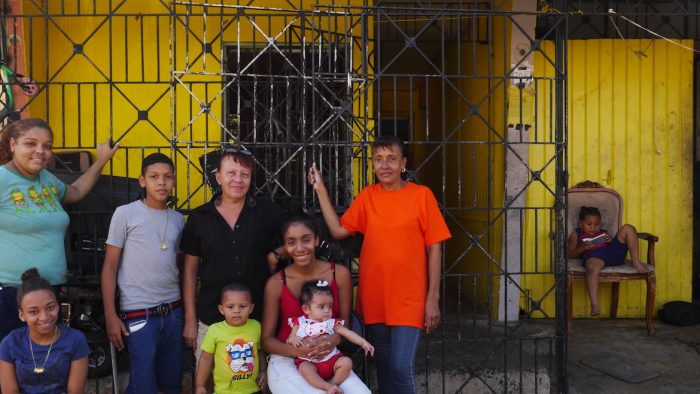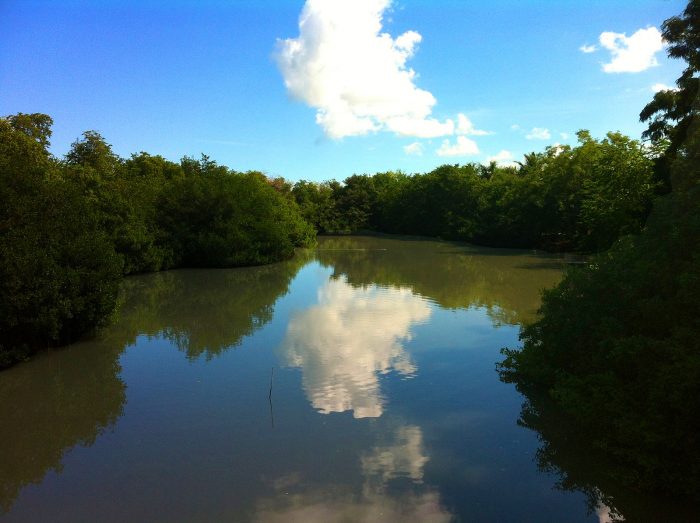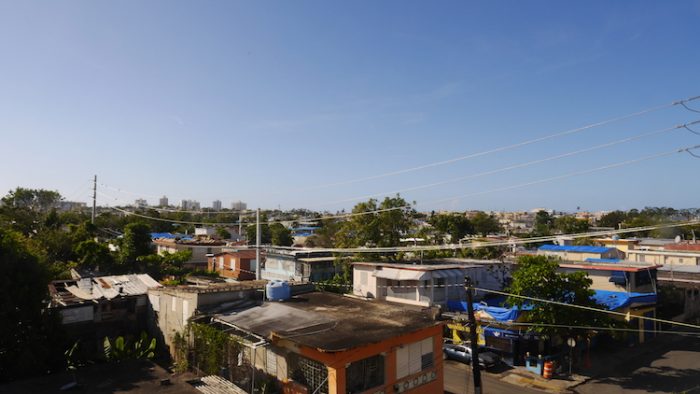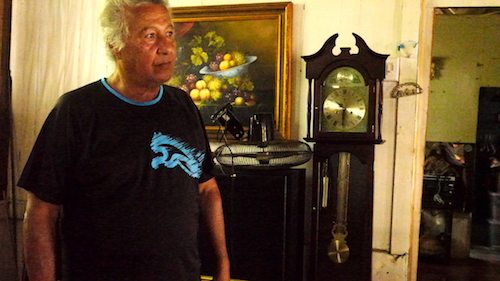by Farnoush Amiri | Special for the Center for Investigative Journalism
Spanish version here.
SAN JUAN — Yolanda Montañez’s home resembles that of a construction site. The floor is bare, with dirt and small holes. There are no walls separating the two bedrooms on the second floor, and all of her belongings are huddled up in plastic bags. But she’s happy because for the first time in almost eight months, she can look up and not see the sky through a blue, plastic tarp but instead a new, brown roof.
For decades, the people of Caño Martín Peña, a neighborhood in San Juan, have dealt with some of the highest levels of poverty, flooding, and gentrification in the country. But when Hurricane María hit, it left Montañez and more than 1,200 members of this vulnerable neighborhood living under blue tarps.


Yolanda Montañez (center, black blouse) in front of her home with her family. (Photo by Farnoush Amiri | Center for Investigative Journalism)
Now the government agency that serves this community’s social, economic and environmental needs is at risk for potential cuts to its budget.
According to the Certified Fiscal Plan recently published by the Fiscal Control Board in Puerto Rico, which imposes several austerity measures, the Corporación del Proyecto ENLACE del Caño Martín Peña is one of the agencies under evaluation by the government either to be consolidated with other agencies or remain independent.
The proposed budget sent last Friday by Governor Ricardo Rosselló to the Fiscal Control Board doesn’t include cuts to ENLACE, but this budget is up for revision by the board and doesn’t guarantee that the agency will not be consolidated in the future. Last year, the Control Board forced Rosselló to make further cuts to his proposed budget.
“What we do here, no other government entity is going to be able to do in the way we’ve been able to,” said Lyvia N. Rodríguez del Valle, the executive director of ENLACE for the past 16 years.
However, Rodríguez del Valle explained that the government has the objective of reducing the total number of government entities to 35, from 131. “Thus, there is still some uncertainty. Informally, we have learned that the current administration has no intent to consolidate ENLACE with other entities,” she said.
The plan also mandates a reduction in the budgetary allocations for all independent agencies in the years to come.
“As we operate in a very lean way, any reduction will have a significant impact,” said Rodríguez del Valle.
In the days and hours after the hurricane ravaged the community, members of ENLACE were the first on the ground in Caño Martín Peña.
When the Federal Emergency Management Agency (FEMA) didn’t immediately show up, the group of community organizers provided the blue tarps to cover the shattered roofs and any necessary medical and emergency aid.
“Prior to María, there was a plan, there was a project and things set up,” said Rodríguez Del Valle. “There were incredible challenges already, like poverty, marginalization and access to education, but we were able to cater to those with a lot of limitations—but then the hurricane happened.”
Those limitations stem from Puerto Rico’s financial status, which like Caño Martín Peña, was in a state of emergency well before the hurricane hit. The island, which has the population equivalent of Connecticut, has a current outstanding debt exceeding $72 billion, more than almost all 50 states, except California, New York and Massachusetts.
“The austerity measure is the worst part of this, the way everything is focused in [Puerto Rico’s] government is to pay the debt, rather than deal with what is happening and prevent people from having to leave their country,” said Rodríguez Del Valle. “[The community] is being forced out and it’s very painful to see this.”
There has been a mass exodus of Puerto Ricans from the island. Pew Research estimates that over half a million people have left the country in the past decade. By the end of 2018, the government projects around 200,000 more residents will flee the island in lieu of permanent residence in states like Texas, Florida, New York and Pennsylvania.
There are various reasons why Puerto Ricans are leaving in droves. For some, it’s the country’s financial status, lack of opportunity and access to education. But for Montañez, her sister Milagros Montañez and their neighbor Luis Ramos, leaving the island was never an option until María—even after years of flooding and inequity.
A Community Flooded With Issues
Caño Martín Peña is a large informal settlement of 26,000 inhabitants originally built on top of mangrove wetlands and is adjacent to San Juan’s Financial District, La Milla de Oro.
The water channel, which runs from the San Juan Bay in the west to Laguna San José and Laguna Los Corozos in the east, is also the epicenter of some of the region’s major public health and housing issues.


A 2012 photo of Caño Martín Peña by the Martín Peña bridge on Highway No. 25 (Photo by Moebiusuibeom-en)
“With rain or without rain, it would flood,” Montañez said of the state of their community before the hurricane.
The residents along the national estuary lack the basic infrastructure to deal with the raw sewage that comes through the channel. Without a proper sewer system, the homes would flood with dirty toilet and sink water years before María hit.
And Then, María
“The situation with the house after the hurricane put me in a depression and that was the only time I considered leaving this community,” said Montañez, who has lived in Caño Martín Peña her entire life.
In the immediate days after the hurricane hit the island, Montañez and her sister took refuge at Puerto Rico Convention Center in San Juan, along with thousands of others.
When her neighbor Luis Ramos heard the initial warnings about the storm, he packed up his belongings, and left Caño Martín Peña with his two dogs and one cat.
When the residents returned, they found their homes uninhabitable—filled with around two feet of dirty, channel water. Their roofs were completely ripped off.
“I spent the first few days in a family member’s home because staying at home felt like living on the street because it continued to rain for the days following the hurricane,” Ramos said.
Over the next month, a sense of hopelessness began to overwhelm the sisters. When Yolanda Montañez finally returned after two weeks to her job as a secretary for the San Juan municipality, she began to feel the effects of post traumatic stress disorder (PTSD).
“When I was at work and anyone would call me and tell me that it was raining or anything, I would start crying and getting stressed and anxious,” she said.
But the hardest part for both women was the effect it had on their grandchildren, who became ill due to the mold and sewer water in their homes. Although these public health issues weren’t new for the families, the impact and heavy debris of the hurricane made it worse.
No Land Rights, No Aid
For many residents of Caño Martín Peña, property rights are another obstacle. Most don’t have the rights to the land they and their families have been living on for generations. This means they can not mortgage, lease or sell the land.


A street in Caño Martín Peña, 2018 (Photo by Farnoush Amiri| Center for Investigative Journalism)
This issue of informal housing became the most prevalent after María, when residents began to apply for aid and were denied on the basis of inability to prove land rights.
“I have the papers, but they are not in the name of my mother or my uncle but in the name of my great grandparents, which is why I was denied assistance from FEMA,” said Milagros Montañez.
According to FEMA records, since the hurricane, the agency has received nearly 1.2 million applications for assistance and has denied 60 percent of those applications because the land deeds are not in their name.
The last time FEMA denied Milagros Montañez’s application for aid was on April 13. By then, she had taken the matter of rebuilding her home into her own hands. A few days prior, a private contractor installed a roof. She is now in the process of changing floor panels on the second story of her home, which aren’t safe to walk on.
But despite the endless obstacles, Ramos and the Montañez sisters keep fighting. There are decades of history and relationships that have been built along Caño Martín Peña.


Luis Ramos (Photo by Farnoush Amiri| Center for Investigative Journalism)
“This home is the center of the family. On the weekend everybody comes here with their kids,” said Milagros Montañez ‘s daughter, Yaxyra Rosario Montañez, as her nieces and nephews run around her aunt’s uneven, concrete floors.
The streets in Caño Martín Peña are filled with generations of residents. There are kids riding their rusted bicycles, older men playing chess, and an influx of neighbors coming and going, checking in on one another. The only thing that seems to have remained a constant for these residents is their sense of community.
“They are tired and they are tired of the government not taking a sense of action. But their sense of belonging is stronger than the situation they live in,” said Mariolga Julia, the special projects manager at the Community Land Trust organization, an entity of ENLACE.
ENLACE won’t give up on this community either. Even as they face potential cuts to their budget, Rodríguez Del Valle believes they’ve put in too much work and too many years to let it go.
She does not want to see the residents moved to public housing, which happened to this community in the 50’s.
“Unfortunately, that seems to be part of the vision that some people still have today on how to approach the issues after Hurricane María,” Rodríguez Del Valle said
For the past few decades, Rodríguez Del Valle says she has seen sketches and proposals for hotels, marinas and other tourist attractions to take the place of these communities.
In less than a month, the 2018 hurricane season is set to begin and the Montañez family and Ramos believe their new roofs will withstand. They are hopeful for the future of their community and Puerto Rico.
But as the U.S. territory grapples with their burgeoning debt and crumbling infrastructure and power grid, they are more vulnerable than ever.
“I can’t even fathom what’s going to happen if there is another hurricane here with the conditions that you see out on the field,” Rodríguez Del Valle said.
***
This story is part of a special project in collaboration with students of the Arthur L. Carter Journalism Institute of the New York University (NYU).


